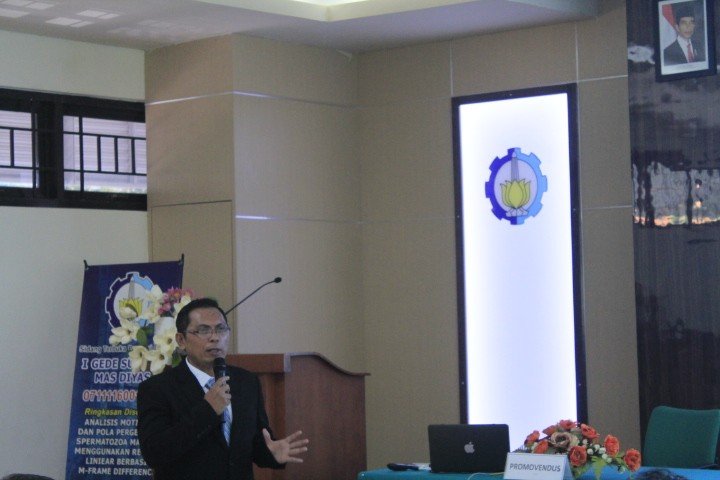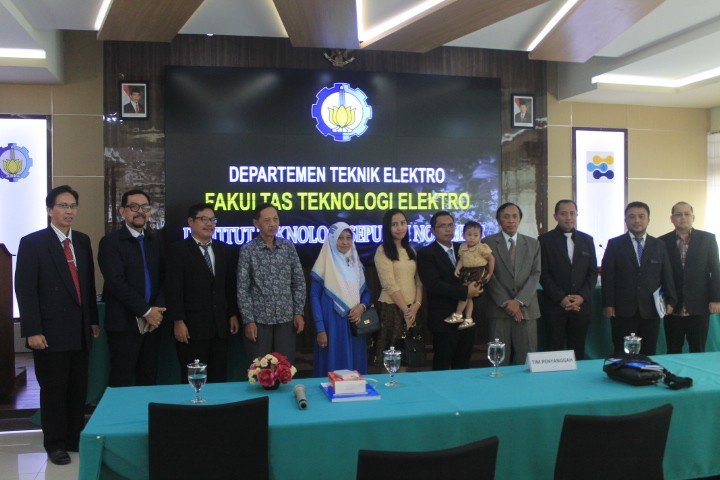ITS Doctoral Candidate Alleviate Analysis of Sperm Damage

I Gede Susrama Mas Diyasa presented his dissertation during an open session of doctoral promotion in the Department of Electrical Engineering ITS
ITS Campus, ITS News – The increasingly sophisticated technology prompted Dr. I Gede Susrama Mas Diyasa ST MT to research human spermatozoa in his doctoral dissertation from the Electrical Engineering Institut Teknologi Sepuluh Nopember (ITS). Based on the experience of checking sperm quality which takes several days, this research is able to shorten approximately four hours of examination accurately.
The man who is familiarly called Gede explained the problem with sperm analysis is currently based on four things. Namely the problem with the equipment used, the ability factor of experts, the speed of observation, and expensive equipment. “On the basis of these four things, the results of sperm examination can differ from one place to another,” said the man who graduated from the Adhi Tama Institute of Technology Surabaya (ITATS).
He continued, the examination of human spermatozoa can be done microscopically and macroscopically. Macroscopic examination can be done in the form of volume, odor, viscosity (thickness), color, pH, and liquefaction. From these results can be known which are normal and abnormal. “If macroscopic, it can be in the form of motility (movement), density, and morphology (shape),” added the man born June 19, 1970.
Gede’s research alone contributed on finding the analysis variable of kinematic spermatozoa through tracking spermatozoa and determining the formulation of the active sperm trajectory. “It can determine the abnormalities of spermatozoa movement based on the path with linear regression and m-frame difference,” explained the graduate of ITS’s Technology Management Masters (MMT) program.
Gede said, from the study will be identified and then validated by labeling based on the results of video recordings of spermatozoa movements. From these results it can be stated that sperm movements resemble parabolic movements. “The speed of spermatozoa can be known and can be standardized,” said the father of one daughter.
Gede said, based on the results of one of his studies, of eight spermatozoa, four of them had speeds above the average. So from this experiment, it can classify the movement patterns of spermatozoa in progressive and nonprogressive classes, as well as classifications of motility (movement) classes. “That way we can find normal and abnormal spermatozoa,” he said.
Gede concluded that the position of the spermatozoa tracking results can be identified in the form of trajectory movement pattern, based on the distance of its position to the linear regression line. While the motility does not depend on speed. “Hopefully this method (the results of his research, red) can be implemented in the society in the future,” concluded Gede. (qin / ITS Public Relation Officer)

I Gede Susrama Mas Diyasa with family and examiners after the doctoral session
Related News
-
Facilitating Creativity of Students, ITS Information Systems Department Presents CCWS
ITS Department of Information Systems students conduct a discussion in one of the available spaces in the ITS Digital
February 20, 2019 23:02 -
ITS Explores Electrification Cooperation with PT Vale Indonesia
ITS Campus, ITS News — Following up on the Memorandum of Understanding (MoU) with PT Vale Indonesia, Institut Teknologi
February 20, 2019 23:02 -
ITS Reaches Top 7 BRIN Collaborators with 309 Scientific Publications
ITS Campus, ITS News — Institut Teknologi Sepuluh Nopember (ITS) continues demonstrating its commitment to strengthening collaboration in research
February 20, 2019 23:02 -
The Only One from Indonesia, ITS Student Becomes Erasmus+ Scholarship Awardee
ITS Campus, ITS News — Civitas academica of Institut Teknologi Sepuluh Nopember (ITS) has once again contributed to making
February 20, 2019 23:02
